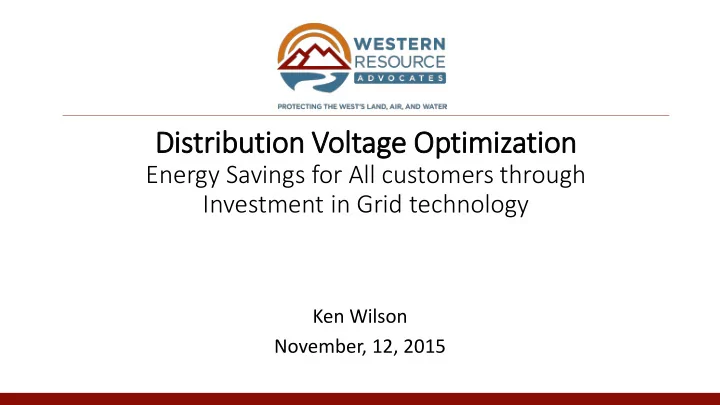

Distribution Voltage Optimization title Energy Savings for All customers through Investment in Grid technology Ken Wilson November, 12, 2015
Distribution Voltages are Higher than necessary • 90% of homes and businesses receive more voltage than they need. - US Department of Energy 2
Average voltages are higher than necessary National Standard - Service Voltage Range 126 - 114 VAC At customer wall outlet 126 V 125 O 124 Upper 123 122.5 National Average Customer Service Voltage Range L 122 121 T 120 119 A 118 Lower G 117 Range 116 E 115 114 3
How do excessive voltages waste energy? A little physics • Power = Voltage x Current (kW) • Energy = Power x time (kW hours) 4
Why Do Utilities Run Voltages High? • Lack of real time voltage measurements at customer meter • Don’t want to get low voltage complaints • Good metering with communication links was expensive in the past • Lack of vendors for integrated solutions • Lack of incentives for investments in improvements 5
The Solution CVR – Conservation Voltage Reduction Also called VVO – Volt/VAR Optimization DVO – Distribution Voltage Optimization Must be done with a software controlled system designed to do CVR – not with traditional, manual CVR 6
What is CVR/DVO? Use a lower voltage range on each feeder 7
How can voltage ranges be reduced? Continuously monitor feeder voltages and use Capacitor Banks (CAP Banks), Voltage Regulators and Load Tap Changers (LTCs) to adaptively reduce voltages on each feeder at a substation 8
Steps to Construct CVR • Levelize the voltage along the length of each feeder • Install voltage meters on each feeder • Install a communication system for information and control • Install automated controls at CAP Banks and Load Tap Changers • Install CVR software to adaptively control voltages on feeders at each substation 9
Voltages on feeders change with load Time of day (morning, afternoon, evening, night) Day of week (weekday, weekend) Season (Summer, Winter, Spring/Fall) Changes in usage (PV systems, EV charging, Large TVs) 10
Modern CVR/DVO adaptively changes voltage CVR system monitors voltages at multiple points on each feeder Voltages levels are communicated to central system Central system considers multiple factors and sends commands to equipment Voltages are adaptively changed based on voltage levels Measurement and Verification process monitors energy savings 11
Does CVR Actually Save Energy Yes! Pacific Northwest National Laboratory (PNNL) If CVR is implemented on every feeder in the US, annual energy consumption will be reduced by 3.04% Pilot projects in multiple utilities have demonstrated energy savings and capacity reduction during peak hours 95% of energy savings is behind the customer’s meter, reducing customer bills 12
Behind the Meter Energy Savings Motors operate on frequency, Air conditioners (compressors and blowers) not voltage - higher voltages Refrigerators merely cause resistive loss Heater fans Washer/drier motors Lighting – reduction in voltage Reduction in energy use for virtually all generally unnoticed as slight lighting types dimming in lights Generally, for each 1% reduction in voltage there is at least a 0.8% reduction in energy use National average estimate of 2% - 3% reduction in ALL energy use 13
Additional Grid Benefits Reduces grid losses by a small amount Building block for other grid improvements Automated Fault location Automated fault Isolation Increased reliability Integration of distributed generation Improved reactive power correction 14
Major Advantages for Customer • Reduces energy use • Reduces customer bills • Provides DSM for all customer classes • Increases rates by small amount, but more than compensated by decrease in energy charges • Rate payer payback in about five years PG&E 15
Major Barriers for Implementation Requires a substantial investment by the utility Reduces utility income in the short term Needs incentives for utility investment Needs ongoing incentives for efficient and innovative operation 16
Status in CO, NV and AZ Colorado – Xcel Energy • Piloted in 2007-2009 • Proposed implementation system wide - $94M investment • PUC ruled DVO is DSM with some DSM incentives • Investment waiting for better incentives Nevada • NV Energy - Large pilot underway in six substations and all subtending feeders Arizona • APS – Pilot on 17 feeders • TEP – Pilot on 4 feeders 17
Questions??
Recommend
More recommend